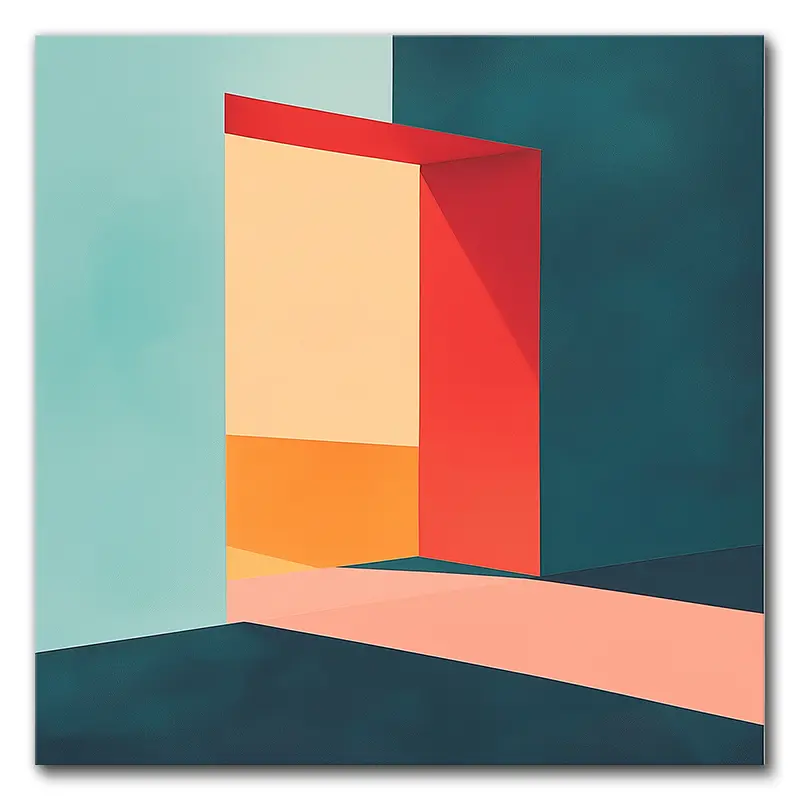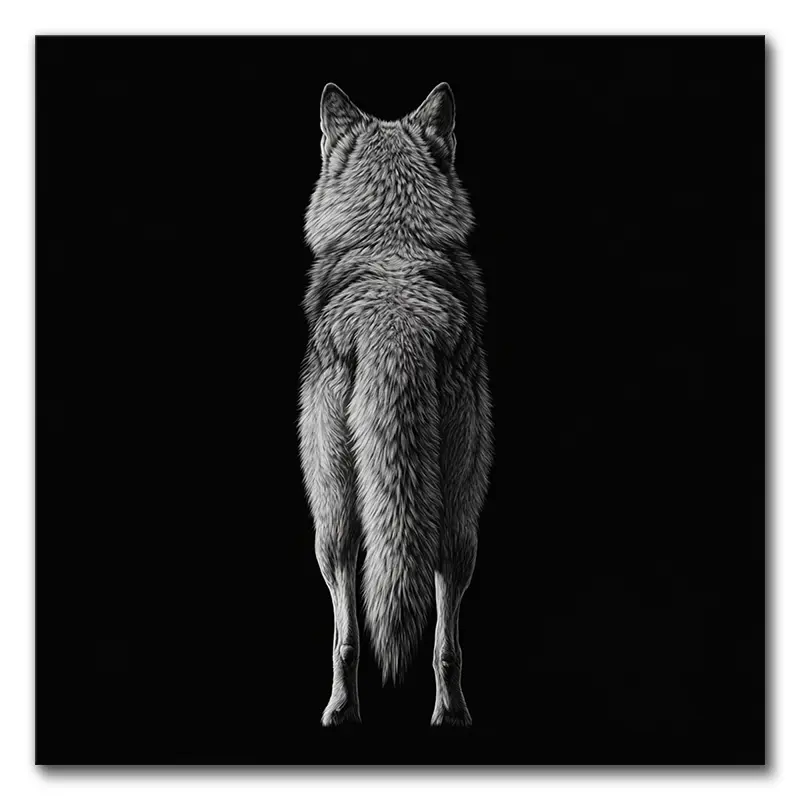Canvas art has a fascinating history, evolving from the oil paintings of the early Renaissance, cherished for their durability and flexibility, to the digital prints we see today. Initially, artists relied on hemp and linen, but cotton emerged in the 19th century, making the medium even more accessible. With advancements in printing technology, like offset lithography and digital printing, canvas art transformed remarkably, allowing personal expression and widespread art access. Today, hybrid techniques blend traditional and modern methods, offering unique creative possibilities. Curious about the deeper implications of these trends? You'll uncover even more surprising insights ahead!
Origins of Canvas Art
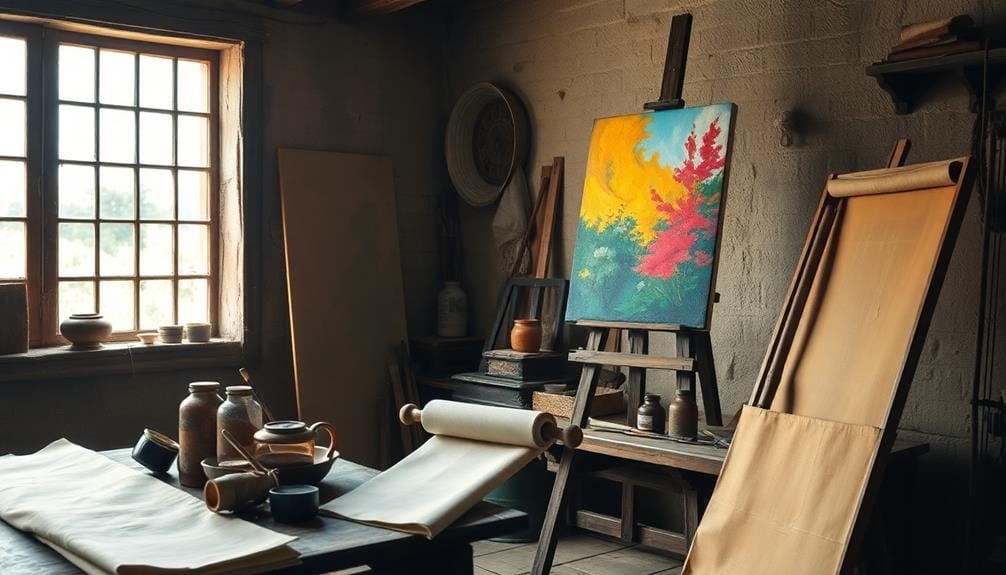
Canvas art emerged during the early Renaissance, around the 14th century, as artists sought a more flexible and durable medium than traditional wooden panels. This shift was revolutionary, as it allowed for greater expression and creativity.
Artists quickly recognized that art oil painting on canvas offered the versatility needed for intricate designs and larger compositions. The lightweight nature of the canvas made it especially appealing, particularly to Venetian painters during the 16th century, who needed materials that could withstand the humid climate without warping or damage.
As canvas gained traction, it spread across Northern Europe by the 17th century, enabling artists to transport their works with ease. Imagine hauling around a massive wooden panel—no thanks! Instead, oil canvas art became the preferred choice, as it allowed for expansive canvases that could showcase elaborate scenes and details.
Major artists, such as Titian and Van Gogh, embraced this medium, further solidifying its place in art history.
The introduction of oil paintings on canvas marked a significant transformation in artistic techniques, as it opened the door to layered and glazed methods, enriching the visual appeal of artworks. Each brushstroke, when applied to this absorbent surface, could create depth and luminosity that wooden panels simply couldn't match.
Consequently, the origins of canvas art not only changed how art was created but also how it was perceived, leading to a legacy that continues to inspire creativity today, reminding us that sometimes, even the simplest things can have the most profound impact.
Evolution of Canvas Materials

Over time, the materials used for canvas art have evolved considerably, adapting to the needs and preferences of artists. In the early days of canvas, hemp and linen were the go-to choices, with hemp reigning supreme until the 19th century. Then came cotton—flexible, affordable, and a real game-changer for artists. You might say it stretched the limits of what was possible, both literally and figuratively!
As artists began to favor cotton, they found it easier to create larger works without breaking the bank or their backs. The process of priming canvas with gesso, a mixture that enhances the longevity and vibrancy of artwork, became essential. This practice guarantees that colors remain rich and durable, even as time marches on. Imagine your masterpiece enduring while the world around it changes; that's the power of proper priming!
Now, in the modern era, you've got an array of canvas materials at your disposal, including cotton, linen, and even PVC. Each offers unique textures and properties, tailored for various artistic techniques. This shift from traditional to contemporary materials reflects not just the evolving preferences of artists but also the demand for lightweight, portable surfaces, perfect for accommodating larger and more intricate works.
In a world where size matters, these materials allow artists to think bigger—quite literally! So, whether you're a novice or a seasoned pro, the evolution of canvas invites you to explore new horizons in your artistic journey.
Historical Significance of Canvas
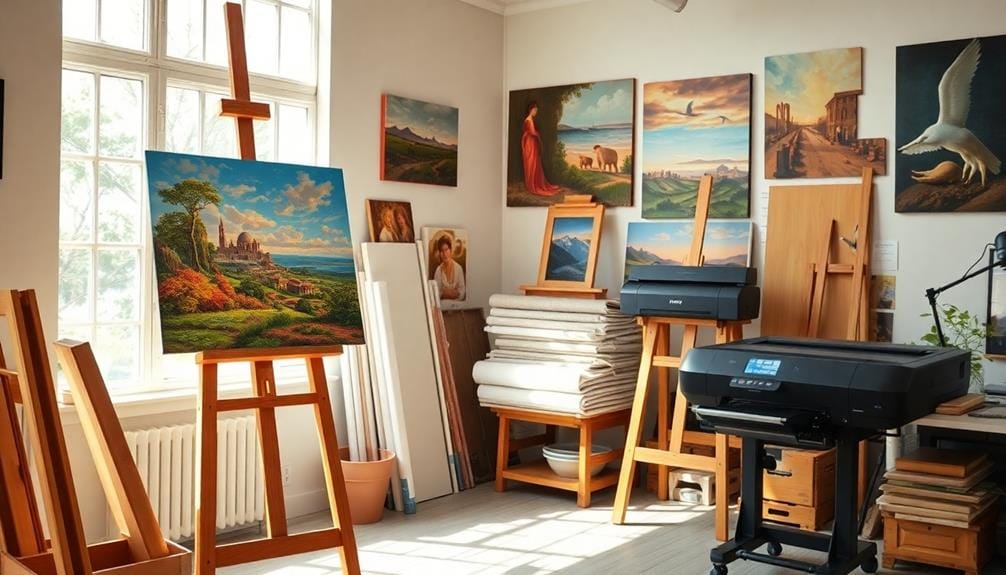
As artists embraced new canvas materials, the medium's historical importance began to unfold. Originating in the early Renaissance around the 14th century, canvas replaced wooden panels, which often constrained artistic expression due to their limited size and rigidity. Imagine a painter yearning to create a grand masterpiece, only to be thwarted by a stubborn piece of wood!
By the 16th century, canvas gained popularity among Venetian painters, who discovered its remarkable ability to withstand humid conditions, enabling them to produce larger works without the warping and cracking that plagued wooden alternatives. This change wasn't merely a matter of convenience; it marked a pivotal moment in art history, greatly influenced by great artists like Titian and Van Gogh. They recognized canvas's versatility, allowing for expansive formats that captured their imaginative visions.
Fast forward to the 19th century, and you'll find cotton taking center stage in canvas production. Valued for its stretchability and durability, cotton outshone traditional materials like linen and hemp, paving the way for more resilient canvases.
As the 20th century rolled in, advancements in printing technology emerged, forever changing the landscape of art reproduction. This innovation allowed high-quality reproductions on canvas, making art accessible to broader audiences, from the art aficionado to your neighbor who just wants a cheerful picture for the living room.
Therefore, the historical significance of canvas lies not only in its physical properties but also in its role in democratizing art, transforming how you and I engage with the creative world.
Transition to Canvas Printing
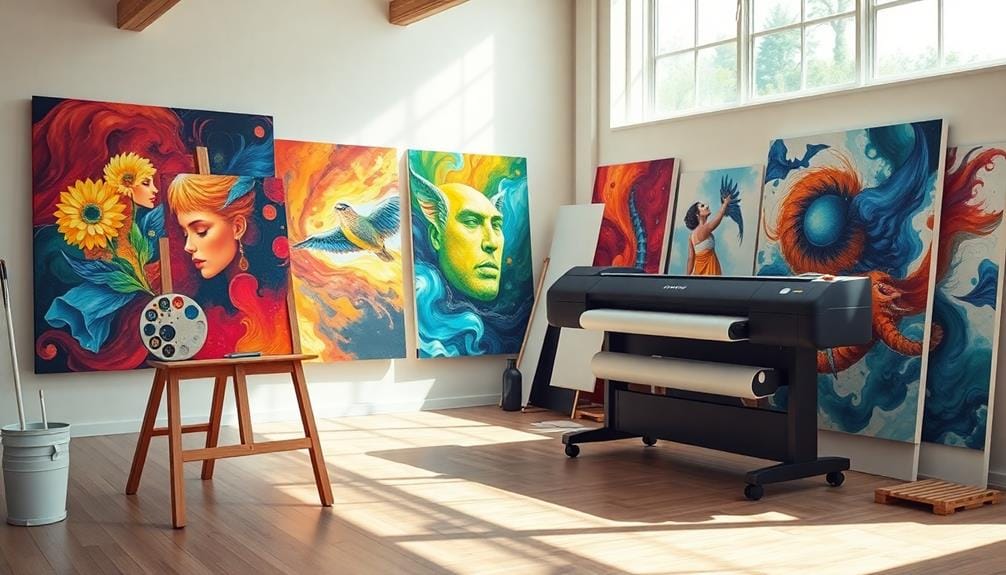
As you explore the fascinating evolution of canvas printing, you'll uncover how early techniques laid the groundwork for what we see today.
With advancements in digital printing and modern applications transforming the canvas art landscape, it's almost like watching art history unfold right before your eyes—without the need for a time machine!
Early Canvas Print Techniques
The shift to canvas printing marked a significant evolution in the art of reproduction, beginning in the 1840s with the first photo printed on canvas. This innovative approach was inspired by traditional fine art materials, merging the domains of photography and painting in a new and exciting way.
Early canvas prints employed the cyanotype printing process, which produced striking blue-toned images that seemed to dance with a unique charm, almost like the canvas was trying to make a fashion statement.
As time progressed, the invention of offset lithographic printing in 1875 gained traction, allowing for more economical canvas production. By the 1910s, this technique became a staple in the art world, making it possible for more artists and enthusiasts to create and share their work.
Fast forward to the early 1990s, when digital color printers arrived on the scene, revolutionizing the canvas printing process. Suddenly, high-quality reproductions from digital images became accessible, transforming photos into lasting home decor.
This evolution in canvas printing techniques broadened the horizons for both personal and professional artwork, ensuring that the beauty of art could be enjoyed by anyone, anywhere.
How's that for a colorful journey through time?
Advancements in Digital Printing
Digital printing has revolutionized the canvas art landscape, making it easier than ever for artists and enthusiasts to create stunning reproductions. The shift to canvas printing began back in the 1840s, driven by a desire to replicate original artworks with the same finesse as fine art materials.
Fast forward to 1875, when the invention of offset lithographic printing allowed for economical production of canvas prints, a trend that gained momentum by the 1910s.
Then, in the early 1990s, digital color printers entered the scene, transforming the ability to print high-quality images on canvas. Suddenly, anyone could transform their cherished photographs into enchanting art pieces, fostering a newfound appreciation for canvas prints.
The past two decades have seen a dramatic increase in demand, as digital photography has become ubiquitous, allowing you to showcase your personal images in a manner previously reserved for professional artists.
Today's advances in printing technology mean that the canvas prints you create aren't only vibrant but also long-lasting, catering to various preferences in size and style.
With these innovations, creating your own stunning canvas art has never been more accessible—or more fun!
Modern Canvas Art Applications
Canvas printing has opened up a world of modern applications that extend far beyond traditional art reproduction. The shift began in the 1840s, allowing photographs to be printed on canvas, inspired by fine art materials.
Fast forward to the 20th century, and advancements in digital technologies made high-quality canvas prints accessible for everyone, transforming how you experience art in your daily surroundings.
Today, you can enjoy a myriad of uses for canvas prints, such as:
- Personalized decor: Create unique wall art that reflects your style, whether it's family photos or your latest travel snapshots.
- Commercial displays: Businesses often opt for canvas prints to enhance their branding and create inviting environments.
- Artistic expression: Emerging artists can showcase their work in a cost-effective manner, reaching wider audiences without breaking the bank.
- Eco-friendly options: Many companies now prioritize sustainable practices, ensuring your art doesn't damage the planet.
With the ability to maintain the integrity of artworks, canvas printing offers a long-lasting solution that caters to diverse preferences.
Advancements in Digital Printing

As you explore the world of digital printing techniques, you'll find that advancements since the early 1990s have transformed how canvas art is created, allowing for stunningly precise reproductions that capture every detail and hue.
With methods like giclee printing gaining popularity, artists can now produce gallery-quality prints that maintain the essence of their original works—almost like magic, but without the rabbits or top hats.
Plus, as the printing industry embraces eco-friendly practices, you can enjoy your canvas art while feeling good about its environmental impact, making your walls not just pretty, but also a little greener.
Digital Printing Techniques
Revolutionizing the art world, advancements in digital printing techniques have transformed how artists and photographers reproduce their work. With the introduction of Giclee printing in the 1990s, you can now enjoy stunning, high-resolution reproductions on canvas, boasting vibrant colors and fine details that rival the originals.
This remarkable technology employs advanced inkjet methods, which have evolved to produce prints with exceptional quality, allowing you to showcase your favorite pieces effectively.
Thanks to these innovations, art ownership is no longer a distant dream. You can create custom pieces from your digital images at a fraction of the cost of original artwork. Furthermore, advancements have enabled the integration of augmented reality features, adding a layer of interactivity to your viewing experience.
Here are some key aspects of digital printing techniques:
- High-resolution Giclee prints capture intricate details.
- Inkjet methods guarantee exceptional color vibrancy and quality.
- Customizable options make art accessible for everyone.
- Augmented reality features enhance viewer interaction.
As you explore these fascinating techniques, you may find yourself appreciating the blend of technology and creativity, redefining what it means to own art in today's world.
Environmental Impact Considerations
The advancements in digital printing techniques haven't only enhanced the quality of art reproductions but also brought significant environmental benefits. For instance, methods like Giclee printing utilize water-based, solvent-free inks, drastically cutting down harmful emissions typically associated with traditional printing processes.
This eco-friendly shift extends to canvas production as well, with artists increasingly opting for materials such as organic cotton and recycled polyester blends, both of which help shrink the overall environmental footprint of canvas art.
Moreover, digital printing allows for on-demand production, so you can say goodbye to those intimidating piles of unsold prints. By eliminating the need for large print runs, waste is minimized, and every piece you order is made just for you—no more art collecting dust in a warehouse!
Many printing companies are also stepping up their game by sourcing materials responsibly and implementing energy-efficient practices.
As the popularity of canvas prints rises, so does the awareness of environmental impact, prompting both artists and consumers to explore sustainable options.
Artistic Techniques on Canvas
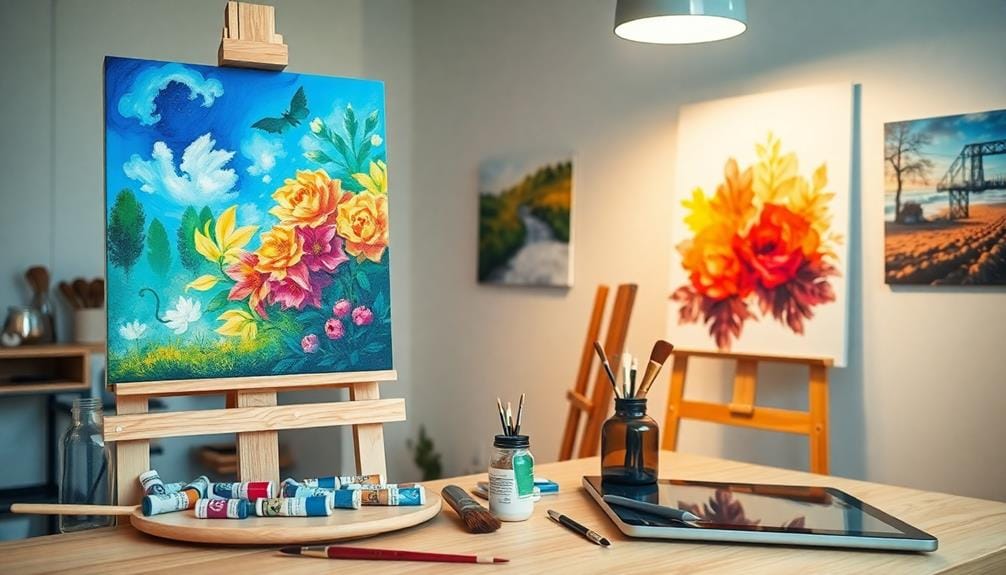
Artists today explore a variety of techniques on canvas, transforming the way we perceive and create art. The evolution from traditional oil painting methods to mixed media and digital printing showcases the diverse approaches artists are now embracing.
With the unique absorbent texture of canvas, vibrant colors come alive, allowing expressions that range from abstract to representational styles.
Some significant techniques include:
- Layering: This method involves applying multiple layers of paint, which can create stunning depth and visual intrigue.
- Glazing: By applying thin, transparent layers of color, artists can achieve a luminous quality that enhances the overall richness of their work.
- Mixed Media: Combining various materials—like paper, fabric, or even found objects—enriches the canvas, allowing for a multi-dimensional experience.
- Digital Tools: Many contemporary artists integrate technology, using digital art software alongside traditional techniques to push creative boundaries.
As you explore these techniques, you'll notice how they reflect a broader cultural shift towards sustainability, with artists increasingly opting for eco-friendly materials.
This not only aligns with environmental responsibility but also adds an interesting layer to their creative processes.
So, whether you're an aspiring artist or simply an admirer of canvas art, understanding these techniques can deepen your appreciation.
After all, who knew that the world of canvas could be so nuanced and full of surprises? It's like finding hidden treasures in a seemingly ordinary treasure chest!
The Popularity of Canvas Prints

Canvas prints have surged in popularity, thanks to advancements in Giclee printing technology that enable high-quality reproductions of artwork and photographs. You might be wondering why this matters—well, it's all about the unique texture and depth that canvas prints offer, which enhances the visual appeal far beyond traditional photo prints.
When you hang a canvas print on your wall, it doesn't just sit there; it seems to come alive, adding a sense of dimension that flat prints simply can't achieve.
Moreover, affordability and customization options have democratized art, allowing anyone with a bit of creativity to showcase personal photographs in artistic formats. If you've ever wanted to take a cherished vacation snapshot and transform it into a gallery-worthy piece, canvas prints have made that dream a reality.
Environmental benefits also play a role in their rise, as companies increasingly use water-based, solvent-free inks and sustainable materials, making your art choices a tad greener.
And let's not forget the digital photography boom, which has led to billions of images being captured every day; this surge in digital content naturally drives demand for printed art forms.
In a world where you can turn your pet's candid moment into a masterpiece, who wouldn't want to explore the enchanting domain of canvas prints?
Future Trends in Canvas Art
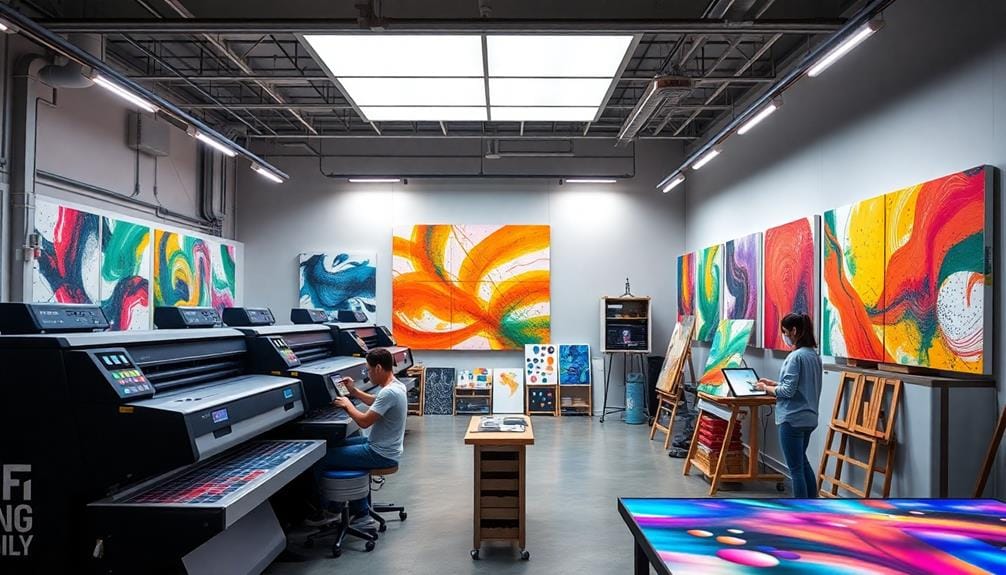
As we look ahead, several exciting trends are set to shape the future of canvas art. The integration of augmented reality features is poised to revolutionize how you interact with artworks, transforming static pieces into dynamic experiences that respond to your presence.
Imagine gazing at a canvas and witnessing elements come to life, enriching your understanding and appreciation of the artist's vision.
Moreover, sustainability is becoming a priority in the canvas art world, with a growing demand for eco-friendly materials such as organic cotton and recycled polyester blends. Artists and manufacturers alike are focusing on greener practices, ensuring that your beautiful pieces are also kind to the planet.
Technological advancements in digital printing are enhancing the quality of canvas reproductions, allowing for vibrant colors and intricate details that make art more accessible than ever. As you explore online marketplaces, you'll discover a plethora of customized canvas prints, giving you the opportunity to personalize your space with unique artworks that resonate with you.
Lastly, the fusion of traditional painting techniques with modern digital methods is creating hybrid forms that reflect contemporary artistic expressions. This blend not only honors the past but also invites you to be part of an evolving narrative in the art world.
In summary, here are four trends to watch for:
- Augmented reality enhancing viewer engagement
- Increased use of sustainable materials
- Improved quality through digital printing
- A rise in custom, personalized canvas prints
The future of canvas art is as vibrant and dynamic as the artworks themselves, inviting you to explore, engage, and connect.
Final Thoughts
As you stand before a vibrant canvas, think of it as a time capsule, capturing centuries of artistic evolution—from the rich textures of oil paint to the sleek precision of digital prints. Just as the ancient Romans used canvas for their grand murals, today's artists explore limitless possibilities, blending tradition with innovation. With advancements in technology, the future of canvas art promises to be as dynamic and colorful as a painter's palette, inviting you to explore and appreciate its ever-expanding horizons. At VerVeLush, we celebrate this artistic journey by offering expertly curated canvas prints that showcase both classic and contemporary styles, ensuring you find the perfect piece to enhance your space. Discover the unique blend of artistry and innovation at VerVeLush, where every canvas tells a story.












